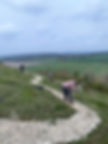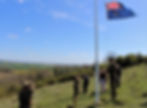Uncovering the Map of Australia in Compton Chamberlayne, Wiltshire
6 min readWiltshire is renowned for its historic white horses and chalk badges carved high into the hillsides. The military badges carved into the...
Wiltshire is renowned for its historic white horses and chalk badges carved high into the hillsides. The military badges carved into the hills of Fovant are well known, but they are not the only World War I badges in the area. The map of Australia had disappeared for decades but thanks to a remarkable group of volunteers, the map is now clearly visible and is the site of an annual service on Anzac Day to remember veterans.

The chalk Map of Australia is in a beautiful setting
A Brief History of the Map of Australia
The county of Wiltshire in southern England is on a seam of chalk which gives the county its rolling hills and the high chalklands of Salisbury Plain. Over the centuries the land has been transformed; by the ancient civilisations who gave us sites such as Stonehenge and the barrows, by the ancient farmers who adapted to the chalky grasslands, and by the military who have used much of the land for over 130 years.
Since the 1890s, the British Army had been buying up land in and around Salisbury Plain. Centrally located in the UK, close to coastline and ports with good train links, it was open landscape with just a small rural population, and by the time World War broke I out in 1914, it was the perfect location to set up military bases, hospitals, training camps and to hold the increasing number of overseas soldiers.

Hurdcott Camp during World War I
Fovant Camp was the most southerly of all of the many and varied camps, possibly chosen as it was already the site of military exercises, and a series of camps sprang up in the area. Soldiers would travel on the London to Exeter trainline and get off at the village of Dinton, and a spur line was built to take men and equipment to Fovant. Hurdcott Camp, near the village of Compton Chamberlayne, was just two miles east of Fovant, and was initially occupied by London regiments.
Although there had been Australian soldiers at the camp since March 1916, by March 1917 it was exclusively taken over by Australian soldiers who were joining the war in ever increasing numbers, and it became their Command Depot No. 3. A mixture of training camp and convalescent camp, the fields around Naishes Farm were filled with trenches, huts, a powerhouse, theatre, a hospital for the wounded to convalesce and up to 4000 men.
The men started carving the map of Australia into the chalky hillside in early 1917. The regimental badges in Fovant were already underway by then, a reminder of home for the men stuck there in an unfamiliar place with unfamiliar weather and people. After the war, the camp was used to hold men awaiting repatriation on the boats back home. When the last of them had left, the huts were removed and the land returned once more to peaceful farmland, with only the chalk badges remaining as evidence of the years they had spent here.
Uncovering the Map of Australia
All of the badges suffered some decline over the years and during World War II, they were deliberately covered over in case enemy pilots used them as landmarks. After the war, the Fovant Home Guard Old Comrades Association (later the Fovant Badges Association) was set up to preserve the badges, and the 1950s saw the restoration of the Map of Australia, with Anzac Day commemorated on the site of the map. By the early 21st century however, the Association did not have the funds to look after the outlying badges, such as those at Sutton Mandeville and the Map of Australia, and soon they were covered in weeds and had faded into obscurity.

Volunteers working on the map
Local resident, Helen Roberts, realised that the map she had seen throughout her childhood had vanished, and explored the area until she found it, writing a letter to the local paper in 2014 asking if there were plans to maintain it. The Fovant Badges were undergoing renewal in time for the centenary of World War I, but the Map of Australia was not being included in the renovations. A very determined lady, she got the farmer, the press and a handful of volunteers on the case and soon was given permission to restore the map.
Every year since, she has led a small group of volunteers who have taken tools up to the top of that very steep hill, and hacked away at the weeds, refreshed the chalk and tidied the edges, so that the map is once again visible from the road which passes below.
In 2023 I saw an article in the local paper, a plea for volunteers, and having previously done a stint on the ancient white horse in Uffington, I joined one of the ‘working picnics’ to help restore the map. It is a very chilled out affair. We met at Naishes Farm, a motley crew of locals and Australians who were either living or stationed in the UK. Grabbing some hefty tools, it was a steep but pretty walk up to the map, and then we each took a section to work on, removing all of the weeds and trimming the edges. We paused to enjoy the picnics we had brought along, with the kids from one Australian family sharing out the Anzac biscuits they had made, which seemed such an appropriate gesture.

There are beautiful views over the valley from the map
The views up there are incredible; the patchwork of fields stretching off into the distance and the clouds chasing across the vast open skies, skylarks could be heard in the woodland below us and birds of prey were circling above us. A tiny dot of a tractor was busily working in the fields, constructing a new vineyard. Helen pointed out where the camp was, where the trainline was, and it was so hard to look at such a serene place and think of how busy it once was with all those huts and thousands of men living, training and convalescing there.
It is a peaceful place and very rewarding work, if slightly hard on underused muscles.
Once shipshape, the map is the location of an Anzac Day service, just as it was in the 1950s, and Australian military and locals join to remember those who were stationed in the camp.
The Anzac Day Service
Every 25th April is Anzac Day. First held in 1916 to remember the antipodeans who had died fighting in Gallipoli, it is now a national day of remembrance for those who fought in both world wars.

The Anzac Day service at the Map of Australia in 2023
Again meeting at Naishes Farm, the group included some of the volunteers, locals, buglers as well as members of the Australian military who are currently deployed in the UK and on exercise on Salisbury Plain, helping to train Ukrainian soldiers. One special guest was Jill, who had come from Australia and whose father was stationed in the camp over 100 years ago.
There were readings of diary extracts from inhabitants of the camp, the Last Post was played, a minute’s silence was held in the bright sunshine high up on the hill, and the leader of the Australian army contingent gave a moving speech, thanking the people of Wiltshire for the ‘care and hospitality afforded to those soldiers,’ for ‘helping us honour their sacrifice and for the enduring restoration effort made in keeping their esteemed legacy alive.’
It was very moving, standing up there in the bright sunshine, watching the world move around below us while listening to the words of former inhabitants of the camp be brought to life by serving Australian soldiers.
After the service, we all gathered in the village hall, which was once one of the huts used in the World War I camp. Over tea and cakes, Major Hand of the Australian Army presented Helen Roberts with a plaque of the map of Australia, in gratitude for all of the work she has done to preserve this important piece of Australian heritage in the Wiltshire countryside.
Just over the road is the cemetery, where 35 soldiers rest, most of them are Australian Infantry and all died during the war. A walk around the graves brings the reality of what happened to them sharply into focus, and shows just how valuable the work of the volunteers is in preserving the map, as the only evidence of the sacrifices the soldiers made in travelling thousands of miles from home to fight a foreign war.
The MOAT website has more information about the camp, or follow the Facebook page for more information about volunteering. I would urge anyone reading this to volunteer next year – it is a truly rewarding experience. If you can’t, they always need donations to buy new tools for working on the map.



